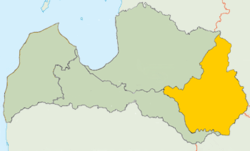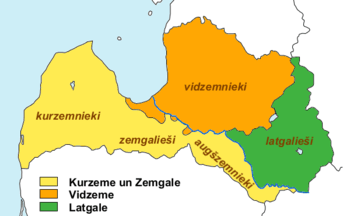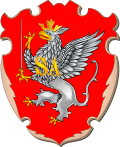Latgale
Latgale (Latgalian: Latgola; Russian: Латгалия; Latin: Lettgallia) is one of the four historical and cultural regions of Latvia recognised in the Constitution of the Republic of Latvia. It is the easternmost region north of the Daugava River. While most of Latvia is historically Lutheran, Latgale is predominantly Roman Catholic: 65.3% according to a 2011 survey.[2] There is also a strong Eastern Orthodox minority (23.8%), of which 13.8% are Russian Orthodox Christians and 10.0% are Old Believers.[2]
Religion in Latgale (2011)[2]
Latgale Latgola | |
|---|---|
 | |
 Flag  Coat of arms | |
| Country | Latvia |
| Area | |
| • Total | 14,547 km2 (5,617 sq mi) |
| Population | |
| • Total | 270,211 |
| • Density | 19/km2 (48/sq mi) |
| HDI (2018) | 0.810[1] very high · 6th |
The region has a large population of ethnic Russians, especially in Daugavpils, the largest city in the region and the location of the region's only public university, the University of Daugavpils. Many of the Russians who lived in Latgale before Soviet rule are Old Believers. Rēzekne, often called the heart of Latgale, Krāslava, and Ludza are other large towns in the region, which also has a Belarusian minority. There is also a significant Polish minority. As part of the Polotsk and Vitebsk guberniyas, the region was part of the Pale of Settlement and had a very large Jewish population – but many of the Jews perished in WW2 and most of the remainder emigrated. Other than in Daugavpils, the Baltic German presence in Latgale was less sizable than in other regions of Latvia.
Average incomes in the region are lower than in other parts of the country.
History
Name
Historically, several different forms of the name Latgalia have been used.
- Other names for the region include Lettigallia, Latgallia, and Latgola.
- The people are called latgalieši in Latvian (as distinct from latgaļi, which refers to the ancient tribe, though some modern Latgalians prefer latgaļi) – latgalīši in Latgalian, sometimes latgali – Latgalians, Latgallians, or Lettigalls in English, and are sometimes referred to as čangaļi (sometimes derogatory – the reference is to a novel, and Latgalians often call other Latvians "čiuļi"). The term latgalieši dates only to the early 20th century, and before that Latgalians were long referred to as Latvians or Inflantians (Latgalian: latvīši, inflantīši).
Since 2004, use of the Latgalian language has been the subject of Europe's biggest sociolinguistic/ethnolinguistic poll and study, conducted by the Rēzekne Augstskola and the Centre d'Étude Linguistiques Pour l'Europe.

As of 2011 97,600 people in the region spoke Latgalian language,[3] which is a standardised form of local varieties of High Latvian dialect.
Early history
Originally the territory of what is now Latgale was populated by Eastern Baltic Latgalian tribe. During the 10th–12th centuries two principalities, Jersika and Atzele, existed on the territory of modern Latgale and Eastern Vidzeme. In addition Latgalians inhabited parts of modern Pskov Oblast in Russia and Vitsebsk Voblast in Belarus.
Medieval Livonia, Duchy of Livonia and the Polish-Lithuanian Commonwealth
| Coat of Arms of Latgale (historical) | |
|---|---|
 | |
| Adopted | 1566 |
In the first decade of the 13th century the principality of Jersika, also known as Lettia, was allied with the Principality of Polotsk and Lithuanian dukes against the Bishopric of Livonia, but was defeated in 1209. Part of it was divided between the Bishopric and the Livonian Brothers of the Sword, the remainder became a vassal country. In 1239, after the death of King Visvaldis, the latter was incorporated into the territory of the Livonian Order.
In 1242, after defeat in the Battle of the Ice, Eastern Latgale (Lotigola) temporarily passed to the Novgorod Republic. In 1263 Livonian knights started to build the Wolkenburg castle near to the Rāzna lake (today within the Rāzna National Park).
In 1277 Grand duke Traidenis of Lithuania unsuccessfully besieged the newly built castle of Daugavpils.
In 1481–1493 Grand Prince Ivan III of Russia temporarily occupied Latgale.
During the Livonian War Latgale was annexed by the Grand Duchy of Lithuania (1559–1562), which in 1569 was incorporated into the Polish–Lithuanian Commonwealth. Ivan IV of Russia annexed Latgale in 1577, but renounced his claims to Livonia in Truce of Jam Zapolski (1582).
In 1621 most of the Duchy of Livonia was ceded to the Swedish Empire, but part of the Duchy including Latgale remained under Polish-Lithuanian control. This became known as the Inflanty Voivodeship.[4] The creation of Polish Inflanty is the birth of the region we now know of as Latgale. During this period the Latgalian dialect was influenced by Polish and developed separately from the Latvian spoken in other parts of Latvia.
Latgale during and after World War I
In 1772, Latgale was annexed by the Russian Empire, and in 1865, as part of Russia's anti-Polish policies, a period of Russification was begun, during which the Latgalian language (written in Latin script) was forbidden. This ban was lifted in 1904, and a period of Latgalian reawakening began. Many Latgalian public figures sought reunification with the rest of Latvia at the Congress of Rēzekne in 1917, while some preferred autonomy or incorporation in Russia. The decisions of the 1917 Congress and the declaration of independence on 18 November 1918, claiming Latgale as part of the Latvian state, moved both Latvian armed forces as well as local partisans to fight for the liberation of Latgale: a difficult task, given the territorial interests of both Bolshevik Russia and Poland.
Latgale as part of independent Latvia
On 31 December 1917, Dvinsky, Lyutsinsky and Rezhitsky Uyezds, populated mostly by Latvians were transferred to Governorate of Livonia, becoming a part of the Latvian Soviet autonomy of Iskolat and a part of the Latvian Socialist Soviet Republic on 17 December 1918. In January 1920, a joint force of Latvian and Polish armies defeated the Soviet 15th Army in the battle of Daugavpils[5]:76–77 which lead to the resignation of the government of Soviet Latvia on 13 of January and Latvian-Russian cease-fire on 1 February 1920.
After signing of the Latvian–Soviet Peace Treaty, parts of the Vitebsk Governorate and Pskov Governorate were incorporated into the new Republic of Latvia. United with other ethnic Latvian territories, as claimed by the declaration of independence (ethnic borders as national borders), they formed the districts of Daugavpils, Ludza, Rēzekne and Jaunlatgale, later Abrene district.
Latgale during and after World War II
A total of 7,671 ethnic Russians from Latgale, representing ten percent of men from the region, served in various units of the Latvian Legion.[6]
In 1944, at the beginning of the second occupation of Latvia by the USSR, the eastern municipalities of the Abrene district including Abrene were incorporated into the Russian SFSR.
Following the dissolution of the Soviet Union and the restoration of Latvian independence in 1990-1991, Latgale regained its status became one of the cultural regions of the Republic of Latvia. Some Russians favour the incorporation of Latgale into Russia, as evidenced by a small demonstration at the Latvian Embassy in Moscow in April 2014.[7]
References
- "Sub-national HDI - Area Database - Global Data Lab". hdi.globaldatalab.org. Retrieved 13 September 2018.
- Iannaccaro, Gabriele (2011). "Sociolinguistica: language and Religion": 102. Cite journal requires
|journal=(help) - Tautas skaitīšana: Latgalē trešā daļa iedzīvotāju ikdienā lieto latgaliešu valodu
- O'Connor, Kevin. Culture and Customs of the Baltic States.
- Davies, N., 1972, White Eagle, Red Star, London: Orbis Books, ISBN 9780712606943
- Böhler, Jochen (2017). The Waffen-SS: A European History. Oxford University Press. ISBN 9780198790556.
- Rally at Latvian Embassy in Russia propagates Latgale as part of Russia, LETA, 17 April 2014
Latgale in foreign languages
- German: Lettgallen
- Swedish: Lettgallen
- Lithuanian: Latgala
- Polish: Łatgalia
- Russian: Латгалия
External links
- lt:Latgala overview in Lithuanian
- Latgale / Latgola overview in Latvian, English, and Russian
- Latgale research center
- a Latgalian site with an online Latgalian–Latvian dictionary.
- Online Latgalian–Latvian dictionary.
- Online Lithuanian-Latvian-Latgalian dictionary.
- Latgalian folk song "Nadūd Dīvs veitūlam"
- Latgalian folk song "Seika, moza mæityneite"
- Latgalian folk song "Īšu, īšu, tæ nabyušu"
- (in Latgalian) News from Latgale
- (in Latgalian) Radio station "Latgales radio"- 64_aac- 64_mp3